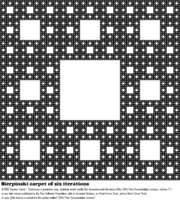Sierpinski carpet
|
|

Fractal_squares.png
The Sierpinski carpet, named after Waclaw Sierpinski, is a fractal derived from a square by cutting it into 9 equal squares with a 3-by-3 grid, removing the central piece and then applying the same procedure ad infinitum to the remaining 8 squares. The Hausdorff dimension of the Carpet is ln 8/ln 3 = 1.8928... It is one generalization of the Cantor set to two dimensions (the other is Cantor Dust); higher-dimensional generalizations are possible, contained inside a cube or N-cube.
A three-dimensional version of the Sierpinski carpet is the Menger sponge, invented by Karl Menger and sometimes mistakenly called a Sierpinski sponge.
For an HTML approach of approximating a Sierpinski carpet, see dive into mark (http://diveintomark.org/tmp/fractal.html).
Brownian motion on the Sierpinski carpet
In recent years, the topic of Brownian motion on the Sierpinski carpet (together with random walk on an appropriate discrete version of the carpet) has attracted much scientific interest. Martin Barlow and Richard Bass have shown that this random walk diffuses in a rate slower than usual random walk: if a usual random walk is after n steps in a distance of <math>n^{1/2}<math> then random walk on the discrete Sierpinski carpet reaches only distance <math>n^{1/\beta}<math> for some <math>\beta>2<math>. They also showed that it satisfies stronger large deviation inequalities (so called "sub-gaussian inequalities") and that it satisfies the elliptic Harnack inequality without satisfying the parabolic one. The existence of such an example was an open problem for many years.
